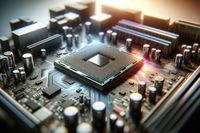We need a moonshot for computing
The US government aims to push microelectronics research forward. But maintaining competitiveness in the long term will require embracing uncertainty.

Setting national policy for technological development
In 2022, the US government passed the CHIPS and Science Act to address the risk of losing its edge in the chip industry. The Act allocated $39 billion for bringing chip factories back to the United States and an additional $11 billion for microelectronics R&D.
The National Semiconductor Technology Center (NSTC) was established as a national 'center of excellence' to drive innovation and invent the next generation of microelectronics.
The US government faces the challenge of making trade-offs and grappling with technological uncertainties. This raises questions about the nature of its interaction with the private sector and whether to focus on short-term competitiveness or place big bets on potential breakthroughs.
The day of reckoning
The chip industry is reaching the limits of transistor scaling, which has been the driving force behind computing advancements. The cost of advancing chips is increasing, and technical challenges are mounting.
To keep chips advancing in the near term, the industry is adopting a two-part strategy: building accelerator chips tailored for specific applications and using chiplets, smaller functional components, to reduce costs and improve customizability.
However, this strategy has its limits, as it continues to rely on the same transistor-building method that is reaching its end. Communication bottlenecks and energy consumption remain challenges, raising questions about the long-term sustainability of chip advancements.
Building an institutional home for moonshots
The alternative to conventional computing is to develop alternative technologies, such as quantum computing, neuromorphic computing, and reversible computing. Washington has the convening power and R&D resources to help these technologies achieve scale.
Building these novel systems requires an entirely new computing 'stack,' from hardware to algorithms and software. An approach that rallies the entire innovation ecosystem around clear objectives is needed to tackle multiple technical problems and reduce risks.
The NSTC can drive these efforts by focusing on moonshot programs, insulating its research program from outside pressures, fostering visionaries, and thoughtfully managing its investment fund.



